For decades the favorite bait for catching cod in Norway has been the pilker (or 'pirk'). Quite understandable since it is easy to fish, also in deeper water and strong currents, and it catches a lot of fish for sure. But we got some interesting news for you: changing to lighter gear and choosing soft baits instead of pirks will result in more and bigger fish. Juul Steyn, co-founder and Norway-expert, shares his knowledge with you so you can improve your catches too. Get ready to catch more and bigger cod and coalfish than you ever imagined possible.
By Juul Steyn / Bookafishingcabin.com
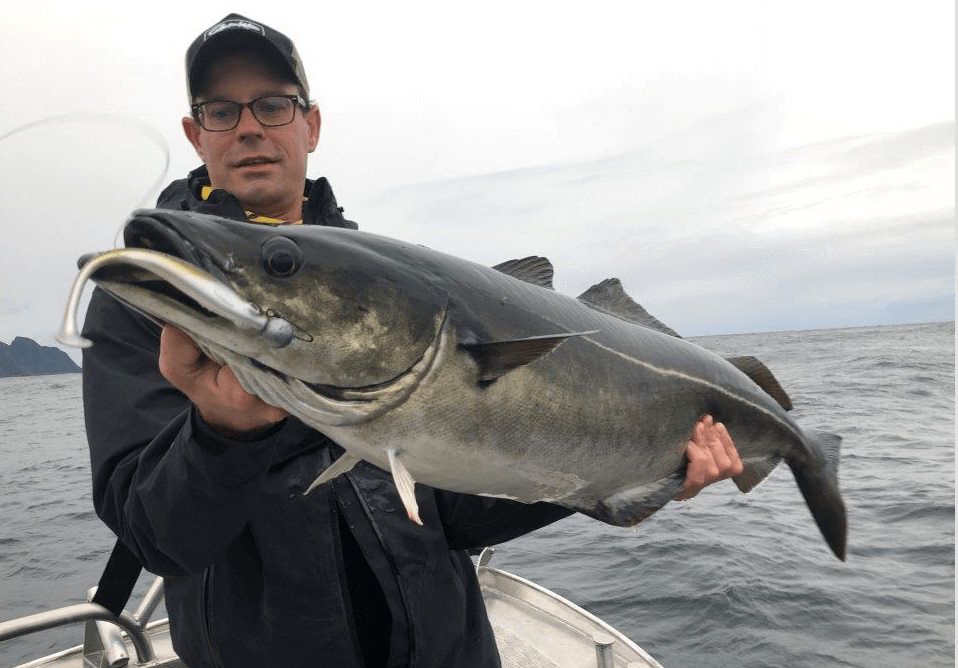
Catching a coalfish of this size is a dream for many anglers. Switch to soft baits and make it happen! (photo: Roel Trum)
Let me get one thing straight first: pilkers are very effective for sure. Especially cod is easily attracted by this swinging and shining metal. Another plus for pilkers/pirks is that anyone can fish this bait, no experience required. Just drop the pilker, let it sink until it reaches the right depth, and start jigging it. Give a good yank and let it drop down again: that’s all there is to it. Most anglers choose to use a paternoster with feathers or octopus imitation above the pilker/pirk to increase the chances of catching smaller cod too. And yes, this is effective because catching 2, 3 or even more fish in one haul is not exceptional.
This all sounds like a no-brainer, right: catching lots of fish in an easy way. What’s not to like? Well, to be honest, there are quite a few things that I do not like. The most important reasons why I choose not to use pilkers are:
- It’s quite boring (jigging up and down all day long seems like work to me)
- You miss most of the bigger fish (much more than you think!)
- It’s a very poor way to fish for halibut and coalfish (and these fish are super cool to catch!)
- I prefer light tackle because it’s so much more fun.
Therefore I want to share my passion for fishing with soft baits so you can improve your catches and have more fun. And when you get back to your fishing holiday home after a great day fishing, you are more likely to have muscle pain of fighting fish instead of jigging a heavy pirk all day.
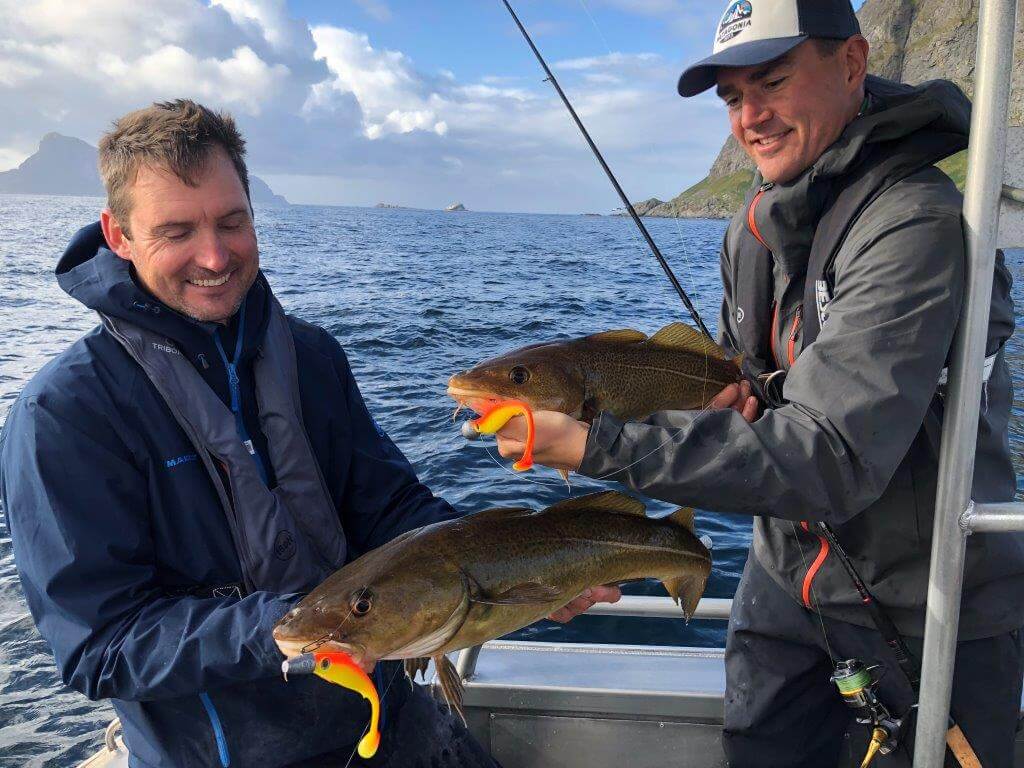
Norway is known for the incredible amounts of cod that can be caught here. By using soft baits instead of pirks you are about to catch more fish and have more fun while doing this. (photo: Roel Trum)
How to fish for large cod, coalfish, and halibut
Fishing plastic lures requires a bit more explanation than fishing with pilkers. But once you know how to do it, your fishing holidays in Norway will never be the same again. Get ready to catch more fish, more species and last but not least: bigger fish.
The perfect rod set-up for Norway
First of all, let’s have a look at the right tackle that is used best. Personally I like fishing with heavy spinning rods and spinning reels instead of boat rods. The reason is that you have to cast the soft baits instead of dropping it under the boat. There are many affordable yet high quality spinning rods for Norway these days, with enough backbone to fight a 100 lb+ halibut if such a monster takes the bait. A good example of such a rod is the Spro Salty Beast Nano Mega Jig Spin. With a length of 7 ft, it’s perfect to handle in the boat and you can cast any jig head with a weight of 4 to 6 oz (113 - 170 gram) all day long.
This rod requires a high-quality saltwater spinning reel in the 6000 - 8000 size, spooled with 30 - 50 lb braid line. Fishing with nylon is simply out of the question: too much stretch, too much resistance. Just go for a good braid. The thinner the braid, the lighter jig heads you can use, but I would suggest to choose no thinner than 30 lb. A 40 lb braid is a good average for sure, giving you enough power to catch the biggest cod, coalfish, and even halibut.
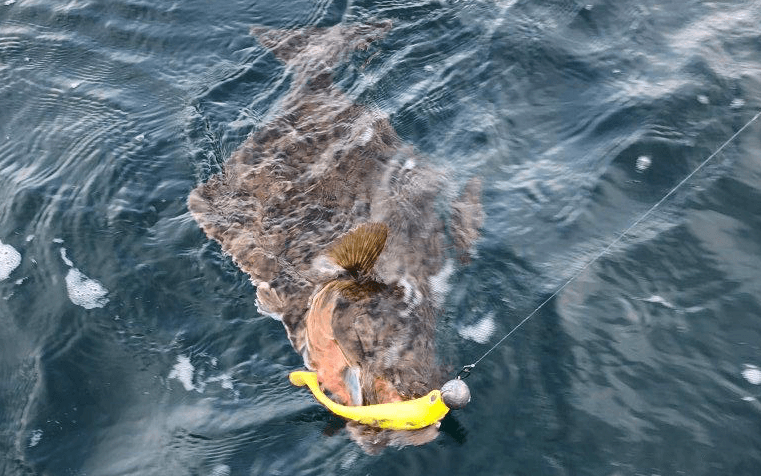
The chances of catching a halibut increase dramatically when you start using soft plastic baits. (photo: Roel Trum)
Always use a leader
Now the last meter: always use a 3 - 4 ft (90 - 120 cm) nylon or fluorocarbon leader with a diameter of 0,8 - 1,2 mm. The reason to use a thick leader is that it offers good protection against rocks and teeth that will certainly cut a braided line within a split second.
Use a reliable knot to connect the leader to the braid. You can use the double Uni Knot, but the most reliable choice is the FG-knot. Not super easy, neither super fast, but certainly most reliable. Check out the great tutorial of my personal fishing hero Briggsy. This film is a great help if you need some instructions to make this knot in your fishing holiday home the night before your next fishing trip.
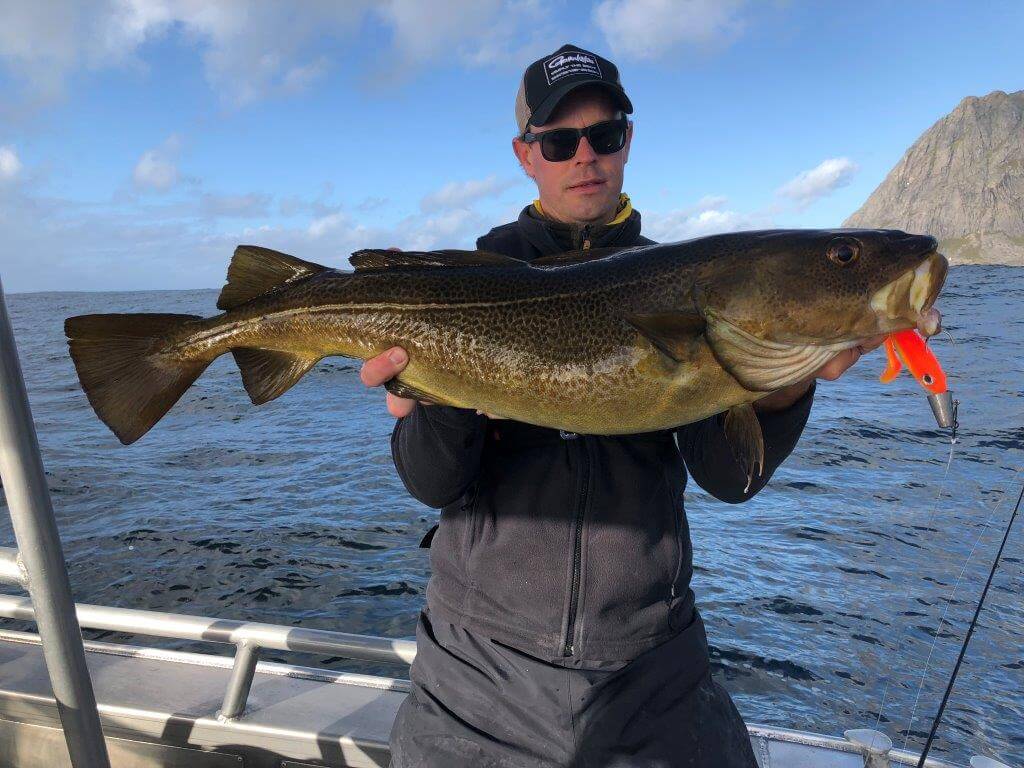
Even during summer time you can catch large cod. (photo: Roel Trum)
Choose the right soft bait
The amount of available soft baits you can buy is simply overwhelming, and most likely you will be able to catch fish on any of them. But I can assure you that there is a big difference between ‘average’ and ‘superb’ soft plastic lures. Over the years I have noticed that the softness and shape make a huge difference.
My personal favorites for large cod are the Gunki G’Bumb (20 cm) and the Illex Dexter (20 and 25 cm). And another amazing new kid on the block is the 23 cm Spro Iris Pop-Eye. This lure is not only very attractive to cod, but also coalfish goes absolutely crazy for this soft bait. The slender body makes it very suitable to retrieve fast in the surface, making it irresistible for coalfish having a feeding frenzy. Fished more slowly it is very tempting for halibut too!
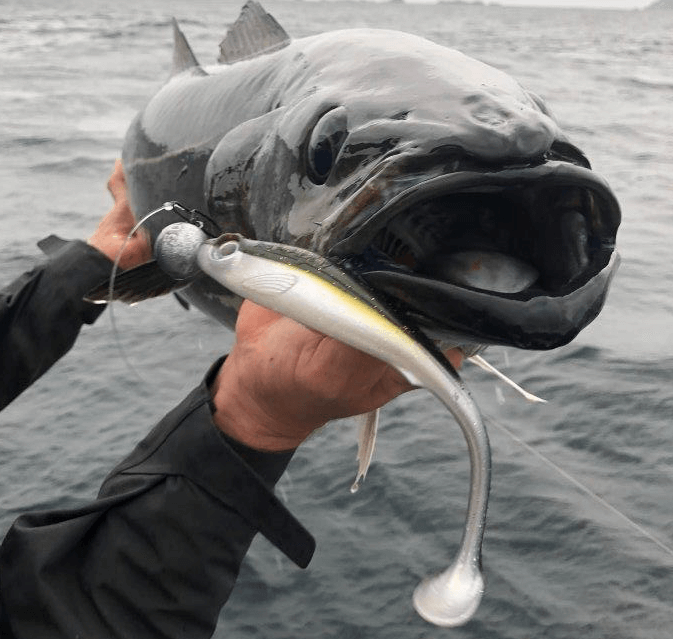
Coalfish have a relatively small mouth, and they just love sand-eel like soft baits. This is the reason why slim baits such as the Spro Iris Pop-Eye are so successful. (photo: Roel Trum)
When it comes to color, it gets a bit fishy. Simply because there are so many colors and all of them will catch fish for sure. However, I have noticed that more natural colored soft baits are easily eaten by basically any fish you want to catch. Think of silver, blue, brown and white - basically in any combination. One ‘unnatural’ color that is doing exceptionally well for cod is orange. No idea why, but just make sure to bring some orange shads on your next fishing holiday to Norway.
Whatever lure you choose, always make sure to use a heavy and high-quality swivel because you don’t want this to be the weakest link. Remember that - especially in the middle and North of Norway - there is always the chance of hooking a halibut of 50, 100 or even 200 lb+. Better safe than sorry!
Now that we have packed our fishing gear, it’s time to leave the holiday home and head to the boat. Get on the water for a great day fishing with big rubber baits.

For some reason cod just loves orange baits. (photo: Roel Trum)
Fishing techniques for cod
Most anglers plan a fishing holiday in Norway because of the amazing stocks of cod that are found here. Targeting them with soft plastic bait required a different approach than when fishing with pilkers. Let’s see what the differences are and how to get the best out of your fishing trip.
First of all, I strongly suggest using a drift bag to slow the boat down and make a nice controlled drift. Try to find an area where you find a shallow part (20 - 50 meters deep) with deeper water next to it (100 - 300 or even 500 meters is considered deep). This is where large shoals of cod like to hunt for baitfish. Also, underwater mountains are great hotspots to find cod.
Once you are drifting, make a cast at in the same direction that the boat is drifting (so the drift back is in your back). Wait till the bait hits the bottom, or till the bait has reached the depth that you have seen fish on the fish finder. Now retrieve a few meters and lift the rod in order to imitate a fleeing fish, and drop the rod tip. The bait will now drop down and this is the moment that cod will catch it. Often you first fill the tension on the line lower, a sign that the soft bait has been gulped when falling down. Now set the hook firmly and enjoy the fight!
I recommend trying different techniques: make larger and smaller movements and see when the number of bites increase and decrease. Please make sure not to let the bait drop too reckless since you always want to have some contact with it. A little bit of slack when dropping the bait is good, but too much of slack will result in less contact with the fish when biting. And thus simply in less fish.
You can also change the kind of bait to find out what they cod is responding to. I recommend to first change the type of soft bait since I believe that this makes the biggest difference. Once you have found a successful bait, you can change the color of this bait to further increase your catches.
Fishing techniques for coalfish
Coalfish (saithe in Norwegian) is pretty much the tuna of the North. They attack the bait super-aggressive, swim very fast, fight like maniacs and they even can be caught on popper lures. We will discuss this last technique some other time, and for now, focus on spinning with soft baits.
A very popular soft bait for coalfish is the sand eel imitation. In general, coalfish prefer more slender bodies that can be inhaled more easily than bulky baits. The reason for this is that coal fish have a relatively small mouth.
Overall it’s safe to say that you can retrieve any bait for coalfish up to twice the speed that you use to target cod. What depth is the right depth? That is an impossible question to answer because coal fish simply follow the baitfish, from over 200 meters depth all the way to the surface.
Once you have located coalfish (either on the surface, easy to spot because of the ‘boiling’ water and diving seagulls, or deeper by finding large clouds on your depth sounder), it’s time to choose the right tactic. If you see the water boiling, smaller fish jumping out of the water and seagulls diving, you are pretty much sure to have found coalfish in a feeding frenzy. I would make the first cast with a sand eel or Spro Iris Pop-Eye and retrieve it at a fast and steady pace. Make sure to hold your rod well because the attack of a large ‘coley’ in general is extremely hard.
If you have found a shoal of fish in larger water when fishing for cod, it may happen that you get fewer bites than expected. In this case, it might very well be that it’s not cod but coalfish. Speed up the speed of retrieving and don’t be surprised that this might be the key so coal fish success!
We hope to have given you some interesting food for thought and will publish more articles soon. If you have any questions about renting a holiday home for your next fishing trip to Norway, we are here to help.
Tight lines!
Juul Steyn
